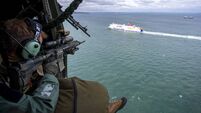On the crest of a wave
The traditional Irish boat is no longer needed for work survival, but Danny O’Flaherty has committed the past 20 years to reviving the boat. He formed Coiste Lar Na gCurrachai (Central Currach Committee) in 1994 to promote currach racing, and the Celtic Nations Heritage Foundation to host the annual World Cup currach regatta in his adopted home of Louisiana.
Like many Irish-Americans, he longs for the country of his birth. Leaving his home in Ardmore, Co Galway in 1967, his journey took him to London, then Chicago and then all over the Unites States as a member of The Irish Minstrels, a traditional Irish folk group with whom he recorded two albums. He settled in New Orleans in 1984.
As Ireland established itself on the European stage in the early ’90s, he became dismayed. Interest in our national language and music was dissipating and his beloved currachs, from which he derived so much pleasure as a youth, were becoming obsolete. So he got together with currach enthusiasts to form Coiste.
“Before we set up the Coiste, there were only two counties — Galway and Kerry — rowing in any kind of regular fashion,” O’Flaherty says. “So our objective was to establish set rules and dates for regattas and to encourage other counties and regions to row.”
Currach clubs began all along the western seaboard from Co Donegal to Co Cork and a points system was devised to encourage regular activity. “You get a certain amount of points for coming first, second, third and fourth,” says O’Flaherty, “and the more you compete the more points you pick up.”
Competition is fierce and missing a single regatta can make the difference between winning and losing.
In the past, competitors were known for using dirty tactics in the water. “Everything was foul,” says Michael King, chairman of the Coiste. “People would obstruct the boat behind them if the thought it was going to over take them, they would flick oars out of the water, that kind of thing.”
So they introduced rules and a referee who sails alongside the currachs in a speedboat. He keeps those back on shore informed via radio.
There are 12 senior men’s, four ladies’ and six junior teams competing nationwide — 80 people in all. They race every weekend along the western seaboard using four standard currachs, provided by the Coiste. “Each club pays an annual levy of €200 to rent the boats,” says King, “which are fully-serviced and used only for racing.”
The type of race differs from bay to bay but typically four currachs row to a distant buoy, round it and pelt it back to cross the finish line. There is technique: if you don’t slow down as you approach the buoy, you’ll shoot past it and if you don’t go round it the right way you have to go back and try again. “You have to understand about winds and tides and all of that as well,” says King.
The regattas in Ireland take place between May and August, though the temperamental Irish weather can drag the season out until September, with teams training all year round.
“We take the boat out three times a week between February and May and twice a week when were in action,” says Eileen Quirke, 44, a childcare supervisor from Kerry. “We take two boats out so we can be in a racing situation, set out courses, conduct sprints and work on endurance and co-ordination.”
When the weather gets too rough, they use the treadmill and the rowing machine. As well as the training, they have to commute along the western seaboard every weekend to ensure points.
“Basically, you’re social life is doomed for the summer,” says Leah O’Sullivan a 33-year-old playschool teacher who rows with the West Clare Currach Club but is originally from Clondalkin, Co Dublin. “There is no drinking and no smoking and you have to watch what you eat.”
The sports gear is simple but needs to be durable. “Even having a pocket in the wrong place can totally throw you,” says Quirke. So it’s tracksuit pants, tight tops and a boot with a heel in it. The tracksuit has to be made of a sturdy material “or you’ll end up with a backside that looks like it came off of a meat slicer,” says Quirke.
To encourage regular attendance, the male and female teams with the most points at the end of the season win an all-expenses paid trip to compete against their American brethren at The World Cup currach regatta in Louisiana. Last year, both the male and female champions hailed from Galway.
“We underwrite all the expenses,” says O’Flaherty. “We don’t get any help off the tourism board, which is only too willing to put currachs into their publicity shots.”
It costs the Celtic Heritage Foundation around $15,000 between airfares, transportation and other added costs, and members rely on the charity of the people of Louisiana and Lake Charles to house the competitors.
“The Hilton in New Orleans used to put people up for the week, but because of the economy they’re unable to do that any more,” says O’Flaherty
The recession has had a bigger effect on currach racing stateside, where 100 people are actively involved, than it has had here. “Everyone is sitting on their wallets,” says Pat Clarke who is the captain of the Pittsburgh Irish Rowing Club. “We used to be heavily sponsored by construction companies but the economic crash killed that dead.”
While the only real expense in Ireland is your lifejacket and your dues, in America it’s a far costlier sport with each club having to rent a marina, buy their currachs and trailers and shell out for travel. “The nearest race to us is Columbus,” says Kristen Scheuing, the Milwaukee captain, “and that’s over seven hours away.”
Organised competitive currach racing began in The United States before starting up in Ireland, when economic migrants in Boston began competing against fellow immigrants in Annapolis and New York City in the early ’80s. Pittsburgh joined soon after, then Albany and by 1982 there were seven teams who bandied together to form the North American Currach Association. It established conformity in the sport, standardising the boats and setting dates for the regattas.
Their season runs from June to September with each club hosting a regatta. While the winners are presented with little trophies and medals, the main focus is on attaining bragging rights.
“It’s a small group but we see each other seven times a year,” says Scheuing. “It’s super competitive. Even if we are all a little older, we might not all be in the best of shape, we all want to get out there and kill the other side.”
O’Flaherty has spent 25 years encouraging a strong Celtic revival in the southern states but his efforts were dealt a serious body blow when Hurricane Katrina hit in 2005. “A lot of the people who were involved left and we cannot contact them. They may have moved to Seattle, Washington, Georgia permanently. So we need to attract new blood to the sport,” he says.
O’Flaherty spends much of his time fundraising and forming separate committees to ensure that the sport remains visible in America.
Although there are no set figures, he estimates that there are 1,000 people actively involved in currach racing around the world. “The plan we had in the early ’90s is working,” O’Flatherty says. “But we’re still behind in our efforts of getting the youth involved. We need to pass the torch on to future generations.”
He hopes that the Irish Government will give the Coiste some funding in future so that they can implement a programme educating school children about their Celtic marine heritage.
“We’re not just a group of people getting together and rowing a boat. We’re making a conscious effort to keep our language, music and all parts of our culture alive,” O’Flaherty says.
















